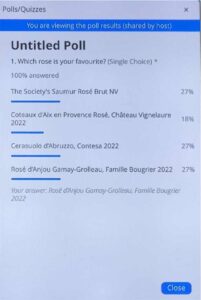
This was a wine tasting with family and a few friends, accompanied by the online ‘Everything’s Coming Up Rosé – Rosé’ workshop hosted by The Wine Society.
The wines in the online tasting were The Society’s Saumur Rosé Brut NV, Coteaux d’Aix en Provence Rosé, Château Vignelaure 2022, Cerasuolo d’Abruzzo, Contesa 2022 and Rosé d’Anjou Gamay-Grolleau, Famille Bougrier 2022.
We had some Berne Côtes de Provence Rosé 2020 that needed consuming, so we substituted that for the Coteaux d’Aix en Provence Rosé. I’m not an avid Rosé drinker, but two of the guests are, so the comments here are primarily theirs.
The Saumur Rosé was noted for its pleasant colour, being unusually dry for a Rosé, sherbert-like and having a good mousse. It’s light and probably best enjoyed on its own rather than with a meal. One of the Rosé enthusiasts found it a little tart.
Regrettably, we had kept the Berne Côtes de Provence Rosé 2020 too long, and it had spoiled. A reminder to myself: don’t keep Rosé for an extended period!
The Cerasuolo d’Abruzzo, Contesa from Italy had a very dark hue that initially deterred some drinkers. Upon tasting, we discovered a redcurrant and cranberry flavour that gave it a distinct and more complex character than typical Rosé. We concluded that, unlike most Rosé, it might pair best with Italian cuisine.
The standout for us was the Rosé d’Anjou Gamay-Grolleau, more representative of Rosé wines with its medium sweetness, absence of sourness and an easy finish.

An online poll was conducted at the conclusion of the tasting. However, like us, not all participants had all the wines which might have affected the results.
Later, my wife and I reflected on the wine selections. We felt that they were chosen to challenge conventional thoughts about Rosé wines and demonstrate that Rosé can be more diverse than expected.
A recording of the online tasting is available on YouTube.













